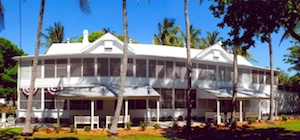Remembering 'Key West's President,' Harry Truman
Harry Truman slept in a double bed in Key West in a room that, by day, was warmed by the subtropical sun. Close to his bed was the simple desk where he wrote daily letters to his wife Bess. Downstairs, on a sun porch overlooking a broad sweep of lawn, stood his discreetly covered poker table.
Despite being president of the United States, Harry Truman could relax in Key West. From 1945 to 1953 he spent 11 working vacations on the island — taking brisk morning walks, playing poker, swimming, fishing and making some of the most important decisions of his presidency.
Truman first visited Key West when his doctor ordered rest to fight a bad cold. Entranced by the island, he quickly adopted the one-time commandant's quarters on the Key West naval station as his "Little White House."
Today, that West Indian structure is a noteworthy American historic site known as the Harry S. Truman Little White House Museum.
Located in an enclave now called Truman Annex, the property is Florida's only presidential museum. There visitors can tour airy, comfortable rooms that look very much as they did in Truman's day, learning about his presidency and Key West sojourns.
The house's easygoing atmosphere offers no hint of the momentous issues decided within its walls. As well as relaxing, Truman used his island visits to consider serious policy decisions and conduct staff meetings away from Washington's more formal atmosphere.
Perhaps the most significant meeting in Key West during his presidency took place in 1948. Although he was not present for it, Truman directed Gen. Dwight Eisenhower to hold a military meeting at the Little White House to reorganize the U.S. Armed Forces. Out of that meeting came the creation of the Department of Defense and the United States Air Force, as well as the protocol for the way the Joint Chiefs of Staff would operate.
In addition, some of the decisions Truman made during his Key West stays had far-reaching effects.
"There are strong indications that he decided to adopt the Marshall Plan while he was in Key West," said Bob Wolz, executive director of the museum and co-author of a book on Truman's Key West years.
The creation of the Marshall Plan, which provided Europe with much-needed funds and assistance to rebuild after World War II, is regarded as one of the highlights of the Truman presidency.
According to Wolz, it was in Key West that Truman decided to relieve Gen. Douglas MacArthur of his command as a result of MacArthur's determination to attack China and escalate the Korean War. Also, the former president was in Key West when he decided not to run for reelection.
Today, docents guide visitors through the meticulously restored Little White House, which contains items including the original piano and poker table used frequently by Truman.
Each May, the museum co-hosts a symposium that examines the enduring influence of America's 33rd president. The 2013 symposium is set for Friday and Saturday, May 17-18, and titled "The National Security Establishment and the Legacy of Harry S. Truman."
During the opening reception on the museum grounds, attendees can meet VIPs like Truman's former White House aide Ken Hechler, who later became West Virginia's secretary of state, and the late president's grandson, author Clifton Truman Daniel.
Since the Truman era, the Little White House has hosted former presidents Dwight Eisenhower, John Kennedy, Jimmy Carter and Bill Clinton, and has been the site of significant modern-day political functions.
Nevertheless, it's Harry Truman whose presence is remembered most clearly in the house and in Key West — perhaps, in part, because he showed such a partiality for the island city.
In fact, he enjoyed his warm-weather retreat so much that he once wrote to his wife, "I've a notion to move the capital to Key West and just stay."

Truman used his island visits to consider serious policy decisions and conduct staff meetings away from Washington's more formal atmosphere. Photo: Harry S. Truman Little White House

Since the Truman era, the Little White House has hosted former presidents Dwight Eisenhower, John Kennedy, Jimmy Carter and Bill Clinton, and has been the site of significant modern-day political functions. Photo: Rob O'Neal

Scheduled speakers at the May 17-18 Truman Symposium titled "The National Security Establishment and the Legacy of Harry S. Truman," include former chairman of the House Armed Services Committee, congressman Ike Skelton.

Harry Truman's presence is remembered most clearly in the house and in Key West — perhaps, in part, because he showed such a partiality for the island city.

